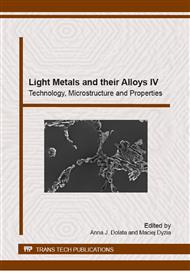p.11
p.17
p.25
p.35
p.45
p.51
p.57
p.65
p.71
The Effect of Metal Forming Direction on the Tribological Properties of MMCp Composites
Abstract:
This article presents the results of the research on tribological composites with AlCu2SiMn matrix that underwent the process of extrusion. The research was conducted on the composites that underwent extrusion, which was carried out with a pneumatic press with a heated matrix of 14mm and 20mm diameter. The research was carried out under technical dry friction conditions in reciprocating motion. The results allowed to describe the influence of the plastic work direction on the tribological properties of the composites reinforced with silicone carbide and glassy carbon. The process of wearing was conducted in two directions: the perpendicular and parallel to the axis of the extruded composite rod. In the examined composites the tribological wear in the direction perpendicular to the direction of the extrusion was greater than wear in the parallel direction. The difference between the values for the parallel and perpendicular directions to the rod decreases with the increase of the degree of plastic work.
Info:
Periodical:
Pages:
45-50
Citation:
Online since:
April 2015
Authors:
Price:
Сopyright:
© 2015 Trans Tech Publications Ltd. All Rights Reserved
Share:
Citation:


